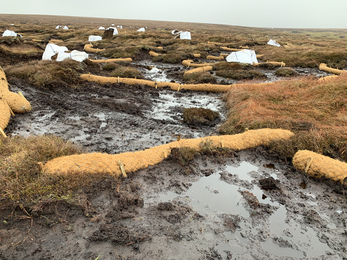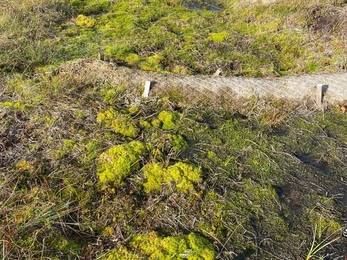The vast majority of the peatlands we restore are managed for grouse, and this means that we cannot get onto the tops until the grouse season has finished; depending on how its gone, that can mean November or December.
Despite contemporary global events, our November 2020 to March 2021 season was one of our busiest ever; when you’re working at a landscape scale and you’re out in the landscape – we estimate there are 96,000 ha of blanket bog in our operational area – social distancing becomes easier to manage. During this season, we surveyed 6,855 ha of that total and completed restoration plans for 5,871 ha.
And because of the previous season’s surveying and planning, we’ve brought 5,048 ha of peatland into restoration management. This has been a colossal effort from the team and our contractors – despite some horrendous weather, we have:
- blocked 156 km of eroding grips and gullies
- Re-profiled and re-vegetated 130 km of grips and gully edges and hags
- Re-vegetated 22 ha of bare peat, mineral soil & micro-erosion
- Planted 173,080 cotton grass plugs and 76,177 sphagnum plugs
- Re-established sphagnum in 20 ha of existing degraded blanket bog vegetation
This is important work because peat is basically carbon and once it’s been exposed to erosion by the weather, it’s carbon that’s going to be joining the atmosphere. We estimate that blanket bog in our operational area holds over 47 million tonnes of carbon, and around 80% of that bog has been damaged in some way since the 50s. That’s a lot of carbon potentially heading in the atmosphere. The good news is that, since 2009, we have been working with our partners, land owners and managers, and funders to bring 36,574 ha of upland peatland into restoration management.
Peatland restoration is an iterative process, of course. We can’t just show up on a site, install some dams and then stick the kettle on. It takes time for our interventions to have an effect. Sometimes we can see change very quickly – see the pictures of Nidderdale taken just a year apart – but more often than not, it’s a matter of returning season after season to see what’s worked and what needs topping up. The past 3 years’ work on Fleet Moss are starting to show results but it will probably take around 10 years for those works to turn all that bog green. We’ll be going back every couple of years to see if anything needs topping up: perhaps this stone sediment trap needs to be another metre higher to keep water on the moor; perhaps the peat is now at the top of these coir bunds and they need another layer on the top. And even when that decade is over, to transform this from gully-riven landscape to one of rolling, squelching green may need yet more intervention. Nonetheless, we are protecting the peat here from erosion and so helping to keep carbon locked therein.


